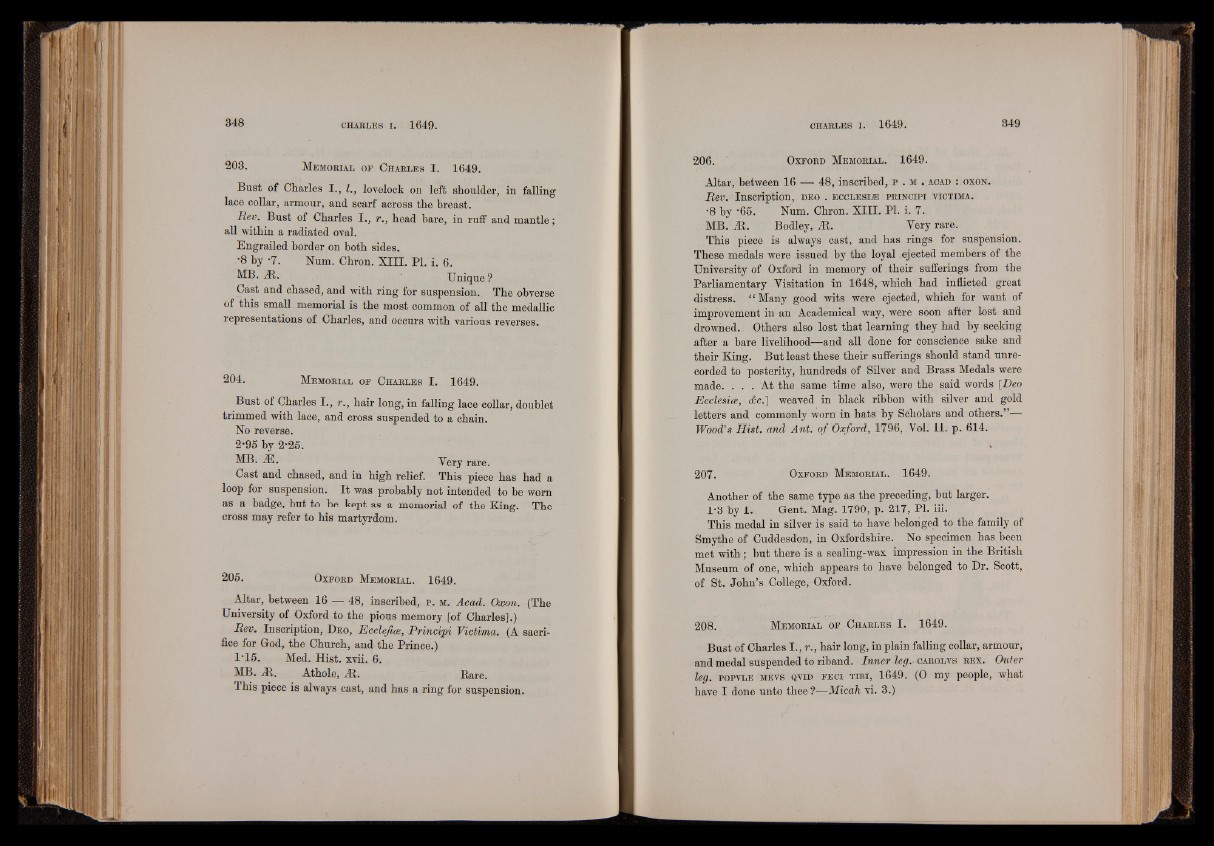
Bust of Charles I., I., lovelock on left shoulder, in falling
lace collar, armour, and scarf across the breast.
Rev. Bust of Charles I., r., head bare, in ruff and mantle;
all within a radiated oval.
Engrailed border on both sides.
•8 by *7. Num. Chron. XIII. PI. i. 6.
MB. At. Unique ?
Cast and chased, and with ring for suspension. The obverse
of this small memorial is the most common of all the medallic
representations of Charles, and occurs with various reverses.
204. M em o r ia l o f C h a r l e s I 1649.
Bust of Charles I., r., hair long, in falling lace collar, doublet
trimmed with lace, and cross suspended to a chain.
No reverse.
2'95 by 2'25.
MB. iE. Very rare.
Cast and chased, and in high relief. This piece has had a
loop for suspension. It was probably not intended to be worn
as a badge, but to be kept as a memorial of the King. The
cross may refer to his martyrdom.
205. Ox fo r d M em o r ia l . 1649.
Altar, between 16 — 48, inscribed, p . m. Acad. Oocon. (The
University of Oxford to the pious memory [of Charles].)
Rev. Inscription, D e o , Ecclejice, Principi Victima. (A sacrifice
for God, the Church, and the Prince.)
1*15. Med. Hist. xvii. 6.
MB. At. Athole, At. Rare.
This piece is always cast, and has a ring for suspension.
Altar, between 16 — 48, inscribed, p . m . acad : .oxon.
Rev. Inscription, d eo . e c c l e s l e p r in c ip i v ic t im a .
•8 by ‘65. Num. Chron. XIII. PI. i. 7.
MB. At. Bodley, At. Very rare.
This piece is always cast, and has rings for suspension.
These medals were issued by the loyal ejected members of the
University of Oxford in memory of their sufferings from the
Parliamentary Visitation in 1648, which had inflicted great
distress. “ Many good wits were ejected, which for want of
improvement in an Academical way, were soon after lost and
drowned. Others also lost that learning they had by seeking
after a bare livelihood—and all done for conscience sake and
their King. But least these their sufferings should stand unrecorded
to posterity, hundreds of Silver and Brass Medals were
made. . . . At the same time also, were the said words [Deo
Ecclesice, dc.] weaved in black ribbon with silver and gold
letters and commonly worn in hats by Scholars and others.”—
Wood’s Hist, and Ant. of Oxford, 1796, Vol. II. p. 614.
207. Ox fo r d M em o r ia l . 1649.
Another of the same type as the preceding, hut larger.
1-3 by 1. Gent. Mag. 1790, p. 217, PI. iii.
This medal in silver is said to have belonged to the family of
Smythe of Cuddesdon, in Oxfordshire. No specimen has been
met with; but there is a sealing-wax impression in the British
Museum of one, which appears to have belonged to Dr. Scott,
of St. John’s College, Oxford.
208. M em o r ia l o f ( C h a r l e s I. 1649.
Bust of Charles I., r., hair long, in plain falling collar, armour,
and medal suspended to riband. Inner leg. carolvs r e x . Outer
leg. po pv l e m ev s qvid f e c i t i b i , 1649. (O my people, what
have I done unto thee ?—Micah vi. 3.)